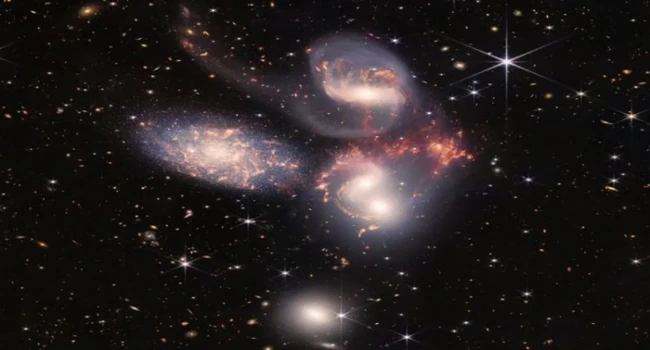NASA’s James Webb Space Telescope has captured stunning images of the cosmos. From distant galaxies to nearby stars, the telescope’s capabilities have revolutionized the way we view our universe. Its infrared technology has allowed us to observe never-before-seen objects and phenomena. Its high-resolution images have revealed the intricate details embedded in the heavens. Here are 10 of the most stunning images captured by the James Webb Space Telescope thus far.
10- Jupiter

The James Webb Space Telescope has captured stunning images of Jupiter. The swirling clouds of the gas giant are clearly visible in the images, providing astronomers with an unprecedented view of the planet’s atmosphere. The telescope has also detected the presence of lightning in the clouds, and the faint glow of aurorae in the planet’s upper atmosphere. The photos also reveal the intricate patterns of swirling storms and swirling currents of gas and dust that form in Jupiter’s atmosphere. This detailed view of the planet’s structure and evolution will help scientists better understand the processes that shape our Solar System.
9- Carina Nebula

The Carina Nebula is a vast expanse of gas and dust located 7,500 light-years away from Earth. Captured by the James Webb Telescope, its intricate details are breathtaking. The nebula is a stellar nursery, filled with new stars and clouds of glowing gas. Its vast size is illuminated by the intense light of massive stars. The bright tracery of the Carina has been revealed in unprecedented detail. Dense knots of gas are lit up by powerful winds from newborn stars. Dark filaments of dust stretch across its bright background. Glowing pillars of gas point to regions where new stars are forming.
8- Neptune Rings

The James Webb Telescope has captured stunning images of Neptune’s rings. Vibrant and colorful, these rings are a sight to behold. Its remarkable resolution reveals intricate details that are otherwise too faint and small to see. The rings appear to be composed of numerous slender arcs, each with a distinctly different color. The colors range from a light blue to a deep red, creating a unique and beautiful palette. Scientists believe the colors are created by particles of ice and dust that reflect different wavelengths of light. The rings also feature a variety of textures, from smooth and wavy to jagged and jumbled.
7- Deep Field

Photo Credit: Big Space
James Webb Telescope Deep Field images offer a mesmerizing glimpse into the cosmos, revealing galaxies and stars billions of light years away. Its unprecedented clarity has allowed astronomers to observe and study far-off cosmic bodies in a way never before possible. The telescope has captured stunning views of swirling galaxies, distant stellar nurseries, and far-off stars that have been forming for billions of years. By focusing on small sections of the sky, astronomers are able to observe the faintest of stars and galaxies, which can provide insight into the earliest stages of the universe’s evolution.
6- Stephen Quintet

Photo Credit: Newsdrum
The Stephen Quintet is a remarkable example of the wonders captured by the James Webb Telescope. This ancient group of five galaxies, each about 100 million light-years away, is seen in the image as a beautiful and intricate web of stars. The galaxies are connected by a thin stream of material, likely due to a collision that happened millions of years ago. The delicate structure is further highlighted by the presence of bright star-forming regions, dark dust clouds, and bright cores in each of the galaxies.
5- Cartwheel Galaxy

Photo Credit: NASA
The Cartwheel galaxy, captured by the James Webb Telescope, is a stunning sight. Its vibrant colors and spiral structure are mesmerizing. The galaxy is estimated to be 500 million years old, making it one of the oldest known. Its unique look comes from two massive bursts of star formation that occurred within its core. The first was caused by a collision between two smaller galaxies, while the second was caused by a collision between the Cartwheel galaxy and a third galaxy. The result is a beautiful ring of stars surrounding a bright, star-filled core.
4- Tarantula Galaxy

The James Webb telescope has captured stunning images of the Tarantula Galaxy, an active star-forming region in the Large Magellanic Cloud. The galaxy is an estimated 170,000 light-years away, but the telescope’s resolution allows it to see the intricate details of its star-forming regions. The new images show a myriad of intricate filaments, pillars of gas and dust, and star-forming regions, all lit up by the brilliant glow of these young stars.
The images provide an unprecedented view of the galaxy, allowing us to better understand the processes that govern star formation. The telescope’s resolution also allows us to pick out individual stars in the galaxy, providing us with valuable insight into the age and composition of the stars in this region.
3- Pillars of Creation

Photo Credit: IGN
The iconic Pillars of Creation are some of the most awe-inspiring images ever captured by the James Webb Space Telescope. These towering columns of interstellar gas and dust are located in the Eagle Nebula, a star-forming region some 7,000 light years from Earth. The pillars are composed of gas and dust that are slowly being eroded by radiation from nearby stars. The beautiful structure of the pillars can be seen as they are illuminated by the bright light from the stars. The varying colors of the pillars are created by different elements and molecules that are present within the nebula. This incredible image captures the beauty and complexity of the pillars and their surrounding environment.
2- Hourglass

The most remarkable of these images is undoubtedly the Hourglass Nebula. The nebula is an incredible site, with its intricate structures and bright colors. It is an active star-forming region where new stars are born and gases are expelled. The nebula is made up of two lobes of gas and dust, which are connected by a narrow waist. The hourglass shape is created by the stellar winds from the two central stars, which blow away the gas and dust, creating a stunning visual effect. This image is truly a sight to behold and is a testament to the power of the James Webb Telescope.
1- Phantom Galaxy

The James Webb Telescope has captured a stunningly detailed image of the ‘Phantom Galaxy’. Located in the constellation of Eridanus, the galaxy is around 11 million light-years away from Earth and is classified as an irregular dwarf galaxy. This galaxy is unique in that it is actively forming stars at a much higher rate than its size would suggest.
The telescope has revealed the presence of young stars, born within the last few million years, in the galaxy. It also shows a population of older stars, that have been around for billions of years. The image also reveals pockets of gas and dust, from which new stars and planets form. This is one of the clearest images of any galaxy taken by the telescope and provides an invaluable insight into its formation and evolution.


